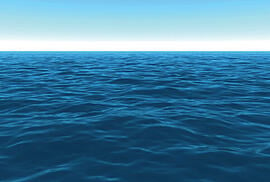 A new paper by researchers from the Woods Hole Oceanographic Institution (WHOI), Wright State University, Observatoire Midi-Pyréneés in France, and the Royal Netherlands Institute for Sea Research found that the ocean contains about “60,000 to 80,000 tons of pollution mercury. In addition, they found that ocean waters shallower than about 100 m (300 feet) have tripled in mercury concentration since the Industrial Revolution and that the ocean as a whole has shown an increase of roughly 10 percent over pre-industrial mercury levels.”[i] The paper, which appears in a recent addition of the journal of Nature “provides the first direct calculation of mercury in the global ocean from pollution based on data from 12 sampling cruises over the past 8 years,” and “a look at the global distribution of mercury in the marine environment.”
A new paper by researchers from the Woods Hole Oceanographic Institution (WHOI), Wright State University, Observatoire Midi-Pyréneés in France, and the Royal Netherlands Institute for Sea Research found that the ocean contains about “60,000 to 80,000 tons of pollution mercury. In addition, they found that ocean waters shallower than about 100 m (300 feet) have tripled in mercury concentration since the Industrial Revolution and that the ocean as a whole has shown an increase of roughly 10 percent over pre-industrial mercury levels.”[i] The paper, which appears in a recent addition of the journal of Nature “provides the first direct calculation of mercury in the global ocean from pollution based on data from 12 sampling cruises over the past 8 years,” and “a look at the global distribution of mercury in the marine environment.”
While mercury is a naturally occurring element, it is also a by-product of human mining and manufacturing operations, from burning coal to making cement. The researchers set out to better understand how much of the mercury in the ocean is a result of human activity or how much is from natural sources. The group looked at data about oceanic levels of phosphate, and by “determining the ratio of phosphate to mercury in water deeper than 1,000 meters (3,300 feet) that has not been in contact with Earth's atmosphere since the Industrial Revolution, the group was able to estimate mercury in the ocean that originated from natural sources such as the breakdown, or ‘weathering,’ of rocks on land.”
As expected, the research found that North Atlantic waters have the most “obvious signs of mercury from pollution,” while the Tropical and Northeast Pacific were “relatively unaffected.”
To determine the level of mercury in the ocean from human activity, researchers looked at databases of C02 in ocean water, which are extensive and readily available. Much of mercury and C02 come from the same activities, and researchers were able to relate the two and use it to determine the amount and distribution of mercury in the world’s ocean basins. This analysis produced the estimated 60K to 80K tons of pollution mercury, which is three times more than since the industrial revolution.
WHOI marine chemist Carl Lamborg said, "With the increases we've seen in the recent past, the next 50 years could very well add the same amount we've seen in the past 150. The trouble is, we don't know what it all means for fish and marine mammals. It likely means some fish also contain at least three times more mercury than 150 years ago, but it could be more. The key is now we have some solid numbers on which to base continued work."
Marine currents have moved a lot of the polluting mercury from the upper layers of the ocean to deeper layers, which are less populated by marine life. Lamborg warned that the ability of deep ocean water to isolate mercury might be coming to an end. Human activity is “starting to overwhelm the ability of deep water formation to hide some of that mercury from us, with the net result that more and more of our emissions will be found in progressively shallower water.”[ii]
If this happens, mercury levels in the ocean food species will increase, as will human exposure.
This study follows a 2007 study from WHOI that found more dissolved mercury was entering the ocean through groundwater than from atmospheric and river sources. Findings from the 2007 study were published in the journal Environmental Sciences and Technology. [iii] A 2013 report issued by U.N. Environment Agency also indicated that mercury pollution in the top layer of the world’s oceans has doubled in the past century.
Teledyne Leeman Labs’ family of mercury analyzers is used by labs around the world to measure the concentration of mercury in solids, semi-solids and liquids. They were the first to offer turnkey operations for Hg analysis techniques:
- Reduction with cold vapor atomic absorption (CVAA) detection;
- Reduction with cold vapor atomic fluorescence (CVAF) detection; and
- Thermal decomposition with cold vapor atomic absorption detection.
Image resource: http://www.whoi.edu/page.do?pid=1
[i] http://www.whoi.edu/news-release/mercury-in-global-ocean
[ii] http://www.nature.com/news/humans-have-tripled-mercury-levels-in-upper-ocean-1.15680
[iii] http://www.sciencedaily.com/releases/2007/03/070321181643.htm


